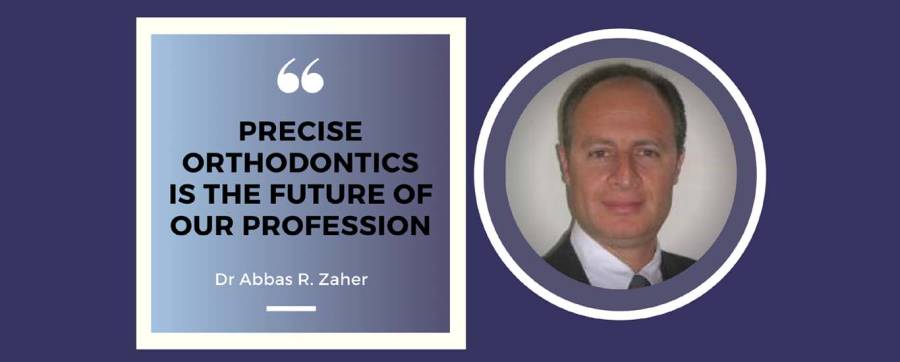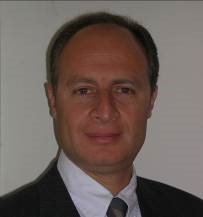
Dr Abbas Zaher is a Professor and past-Chairman, Department of Orthodontics at the University of Alexandria, Egypt.
by Dr Muattar Hanif
After becoming a Doctor of Dental Surgery (DDS) from the University of Alexandria in 1981, Dr Zaher continued to pursue Masters of Science (MS) in Orthodontics from the University of Alexandria in 1986. He later then completed his post-doctoral degree (PhD) in Orthodontics from the University of Iowa, USA, and the University of Alexandria, Egypt in 1992. Dr Zaher was also visiting fellow at the University of Iowa USA from 1989 till 1991. He also earned a fellowship in the International College of Dentists and Pierre Fauchard Academy

Dr Zaher’s contributions to the field of Orthodontics lead him to appoint as the Vice-President of the World Federation of Orthodontists. He is also a founding member of the Arab Orthodontic Society, an international member at the American Association of Orthodontists, member of the European Orthodontic Society.
For his outstanding achievements, Dr Abbas has been awarded the Helen and B. F. Dewel Clinical Orthodontic Award for the best Clinical Article in the American Journal of Orthodontics and Dentofacial Orthopedics, 1995. He also received honourary membership in the Romanian Association for Excellence in Orthodontics, honourary life member in the Greek Orthodontic Society, and honourary member in The Asociacion Mexicana De Ortodontcia. He is also the recipient of the World Federation of Orthodontists ‘Regional Award of Merit,’ 2018.
Dr Abbas is currently the President of the Egyptian Orthodontic Society and holds more than 50 scientific publications in Egyptian and international journals.
Recently he exclusively spoke with Dental News Pakistan to talk share his immense knowledge regarding Orthodontics for the dental community residing in Pakistan.
Dental News: We all know that orthodontic treatments help us improve the smile, but what are some health benefits?
Dr Abbas Zaher: Having a good smile is in itself a health benefit that impacts one's wellbeing. The present state of a malocclusion perse is not as much of an issue as the consequences if left untreated. Orthodontic treatment helps resolve mild problems such as crowding, rotations, and spacing, causing food impactions, and when left untreated, could contribute to severe periodontal issues and dental caries.
Orthodontic treatment also resolves more severe and severe dental problems in cases where there is a lack of proper occlusion. When left untreated, it could lead to Temporo-Mandibular Joint dysfunction, mouth breathing, malnutrition, etc., contributing to a chain reaction to health problems.
Good oral health is an essential part of our well-being. We can’t separate the condition of the oral cavity from the rest of our body.
For this reason, the main objectives of any orthodontic treatment are to restore proper function and esthetics. In addition to the tremendous positive impact on the smile, the correction of malocclusion will help keep good oral hygiene, maintain correct masticatory and speech functions, and ensure the dentition's longevity.
So how do you know if one needs orthodontic care?
Early diagnosis is the key. Today a lot of parents are aware of certain dental states such as delayed eruption. Every case is different; some children require orthodontic intervention, which could start in their primary or mixed dentition, such as reversed overbite in the posterior or the anterior teeth, involving one or more teeth, also severely protrude anterior teeth warrant early interference to avoid potential trauma. Also, severe crowding in the mixed dentition phase might require the implementation of a supervised serial extraction plan. Others need a follow-up throughout their dental development until the completion of the permanent dentition set.
The need for orthodontic treatment in adults is different; it is mainly motivated by esthetic demands and usually entails a multidisciplinary team working with general dentists to achieve the desired functional and esthetic outcome.
There is a general desire found among the masses for a ‘perfect smile’. What is the perfect smile according to you?
An esthetically pleasing and healthy smile is complex. It requires a skilled eye and experience to achieve a balanced, harmonious smile that fits the patient facial character and dimensions. Many minor factors come together to produce this ‘perfect smile,’ such as contact points, embrasures, line angles, papilla, tooth angulation and alignment, gingival alignment and show, width, and curve of smile, and so on. When all factors stand in harmony, then it is a perfect smile.
Do you agree that social media has fuelled this quest for a perfect smile more?
Social media is an excellent factor for awareness nowadays. It has a significant impact on the perception of beauty, including an attractive smile.
At the same time, some patients started to build unrealistic expectations. For this reason, I always advise my patients to get the information from reliable sources (academic associations, etc.), and I keep reminding them that each condition is unique. What fits one patient may not provide the other.
What are the pros and cons of Clear Aligners vs conventional braces?
Aligners are a great, hygienic option for many cases, being removable, transparent, and esthetic. Their use requires a great deal of cooperation on the patient’s side. Unfortunately, if used in unindicated instances, the treatment time might be prolonged, and the finishing may be compromised. Proper case selection and adequate education and experience are essential factors in the success of aligner treatment. Treatment with aligners will progress smoothly in many cases. Still, when treatment does not advance the way it is anticipated, only a creative and experienced eye can discover the cause of the problem and describe ways to resolve it. Conventional braces, on the other hand, are not as esthetic. However, clear braces are esthetically quite acceptable but generally can elicit excellent results and achieve perfect root alignment, especially when significant tooth movement is needed.
There is a general preference to opt for new treatment procedures like Clear Aligners etc. Do you feel there is a rush for dentists to endorse them?
Being up to date regarding new technology is essential. Many companies make treatment with clear aligners seem easy and guaranteed without studying further or compile experience. However, like any other modality, the dentist needs to have a good basic knowledge of malocclusion correction with clear treatment objectives and definite step-by-step teeth movement.
No one can stand in front of the train of the future. Clear aligners are gaining wide popularity; patients like and ask about them. Although they require less chair time, proper planning of the teeth movements and placements of attachments are not easy and are considered crucial to ensure treatment success. Moreover, until now, they can’t solve all forms of malocclusion; many cases still require conventional orthodontics, and here comes the concept of patient selection.
Post-treatment retention seems to be a considerable problem for dentists and patients alike. How do you think orthodontists should respond?
First, we need to understand the difference between relapse and age changes! Relapse is an immediate return to the original tooth position after treatment and usually occurs within the first year after treatment. However, dental changes never stop as long as the individual is alive. The patient has to accept some dentition changes over the years, and if changes reach a point they don’t like, they can have another stage of orthodontic treatment. The only way to keep the teeth alignment, such as orthodontic treatment, is to continue retainer wear indefinitely.
In orthodontic practise, it is common practice to explain to the patient/parent that the retention phase is just as important as the treatment phase.
The patient and the orthodontist have to work together on that matter. Because there is an excellent part of it depending on younger patients, second orthodontic treatments are sometimes inevitable.
There are issues of discrepancy faced by orthodontists. What suggestions would you make for those who want to make practical cephalometric analysis?
This is a controversial question. There are many different schools for lateral cephalometric measurements, depending on what you want to analyze and the case.
It is important to stress that cephalometric measurements are tools that help the orthodontist diagnose and manage the dentofacial discrepancy. I always remind our residents that we are not treating the numbers, but we are dealing with the patient as a whole. From this context, I would say proper understanding of the parameters, whatever the analysis used, would guide the orthodontist to deal with the condition and the other diagnostic tools.
Do you feel our university programs are preparing orthodontic graduates for problems of managing a modern orthodontic practice?
The critical benefit in joining a certified graduate program is the exposure to a wide range of clinical scenarios, with the opportunity to learn from qualified orthodontists how to deal with different forms of malocclusion. Our mission is to develop a qualified orthodontist in our department at Alexandria University who can critically appraise literature and use an evidence-based approach to ensure the delivery of high-quality orthodontic treatment. We try to cover the clinical treatment of many different cases together with supervision. The student takes on a certain number of other cases, which is part of the requirements needed to graduate.
After doing our part, experience and skill need to be practised, of course.
We prepare the orthodontic student for all kinds of different cases. A weekly seminar is a must, where we discuss other cases with various treatment options.
What research programs would you like to see undertaken within the next ten years, and how do you think they would affect dentistry?
Technology is running fast; I think digital scanning, analysis and treatment planning, and 3D printing need more clinical research to become standard practice.
Precision Orthodontics is the future of our profession. How to use the advances in biomedical innovations and three-dimensional technology to tailor a specific treatment plan for every patient. For this reason, I have been shifting my research interest recently to focus more on the promising applications of 3D technologies and biomedical modulations in orthodontic treatment.
Any special message for young dentists?
As dentists, we trust our patients, and by keeping our ethical and moral principles, we prove this trustworthy.
Dentistry requires commitment, ambition, and a lot of continuing education; keeping up to date in our field is essential.
Teamwork and continuous education are the primary keys to success in our profession. Orthodontists need to work with skilful dentists from other specialities to ensure the best treatment outcomes for our patients.

Dr Muattar Hanif
The author is Editor at Dental News Pakistan and can be reached at newsdesk@medicalnewsgroup.com.pk

